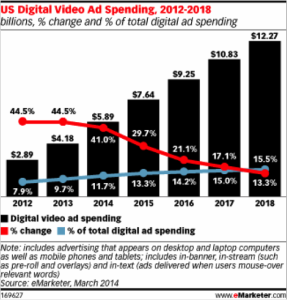Great Content for Your Audience. . . Yes, that Includes the Ads!
As a publisher, you pride yourself on creating exceptional content that your audience loves and shares. But when it comes to the advertising, are you giving your user experience the same attention to detail? Furthermore, is there even such a thing as a good user ad experience? We think so… because whatever advertising solutions you employ, your audience’s affinity and attitude towards them will ultimately dictate your monetization success, and some sites are proving savvier in this regard than others.
Introducing: Native Advertising
Let’s begin with a few quick stats. Consider the following: IPG Media Lab’s native advertising study found consumer subjects viewed native ads 53% more frequently than banners, were 68% more likely to share a native ad with others, and exhibited 18% higher purchase intent after viewing.
On the buyer side, 26% of surveyed mobile advertisers indicated they already buy native mobile ad placements, with an additional 37% indicating they plan on doing so soon.
With a whopping 97% of those buyers reporting that native ads were “very or somewhat effective” at achieving branding goals, a glaring win-win scenario emerges between publishers and advertisers: on the one hand, advertisers see higher engagement rates and their spending increases; on the other, you have an ad experience your audience is choosing to engage with—an experience that boosts their perception of your site because of the fundamental nature of these ads: “native.”
So what is native advertising? Quite simply, it’s advertising which is integrated seamlessly (i.e. “natively”) into your website, mimicking content for users to engage with, rather than appearing overtly advertorial. Facebook’s “Promoted Posts” are one example, as is Forbes’ BrandVoice program.
Think of native ads as the digital equivalent to a product placement in a movie. Most people understand that the Camaro which transforms into Bumblebee in the Transformer franchise is a decades-spanning promotion endorsing Chevy, but does anyone mind? No, because it fits into the storyline natively, all without disrupting the movie experience.
And it only makes sense! As a consumer, what sounds more appealing: browsing a site with constant pop-ups, or choosing to engage with ad content that appears as a natural function of the site experience? The choice seems obvious.
But before you go removing all non-native ads from your site, it’s equally important to note that native advertising is not an “end-all be-all” solution; on the contrary, it’s merely a great supplement. Advertiser spending remains heavily skewed towards traditional formats like display and banners as long as consumers are still engaging with them—and this will continue, for many years.
Nevertheless the slow but steady shift of savvy advertisers’ budgets to native is ongoing, fueled by these ads’ continued strong performance. In other words, the sooner you embrace native, the better positioned you’ll be when the advertisers come knocking. And yes, they’re knocking.
Best of all, native ads can be incorporated without adversely impacting your current website experience, so you can start testing it at any time.
Introducing: Video Advertising
Time for some stats again! In March 2014 alone 187 million Americans watched 28 billion online video ads. It’s no wonder Cisco predicts video traffic will make up 69% of all consumer Internet traffic by 2017, and why YouTube already pushes a staggering one billion unique visitors from around the world, monthly.
For publishers considering video ads, better site engagement and ad performance await you. According to MediaMind, videos had a Click-Through Rate (CTR) of 1.03% in 2012, more than 10x higher than that of traditional banners, and a mobile ad company, Celtra, saw mobile native video ads outperforming on engagement metrics across the board. Advertisers are certainly pouring money at this medium.

And for these very reasons, eMarketer writes:
“Digital video advertising will make up nearly 12% of all digital ad spending in the US this year and is projected to grow significantly faster than search or overall display advertising for the next several years…” By 2017, online video ad spending will have doubled what it is this year.
Put bluntly, just about every online video statistic out there indicates the same conclusion: online video is unquestionably becoming consumers’ preferred content medium, and it isn’t going anywhere. So, if there’s a single bit of advice to take away from this post, it’s this: taking advantage of this increasingly video-centric consumer behavior is imperative, and if you haven’t already incorporated video into your site, whether through content or ads, make it your2014 priority.
Introducing: Programmatic Advertising
It was recently the 2-year anniversary of Digiday writing about “programmatic marketing” and what it means for the future. Ever since then, nothing short of a storm of industry-wide commotion surrounding the use of this tool has commenced. So what is programmatic, and what does it have to do with advertising?
Looking at the word itself, we find “program” at the root. An indication of its function, something which is programmatic is automated and algorithmic-based (just like a computer program). When applied to advertising, it is simply the idea that data and algorithms can be utilized to deliver the right ad, to the right person, at the right time, at the right price (negotiated, determined, and executed in real-time by a formula that optimizes both the buyer and seller side of the ad placement equation), all in a manner many times more efficient than a person.
And boy is it getting popular. According to the Interactive Advertising Bureau, 85% of advertisers use programmatic ad buying strategies and 91% expect to do so within the next couple of years. Advertisers and publishers alike are rapidly adopting programmatic advertising across different ad formats, and as Maja Millicevic from ClickZ put it, “those who don’t will remain in the world of dwindling CPMs and ‘race-to-the-bottom’ conversations.”
I hope you enjoyed the read. Are you using programmatic? Native? Video? Have experiences or questions about any of them? Let’s discuss in the comments section!

